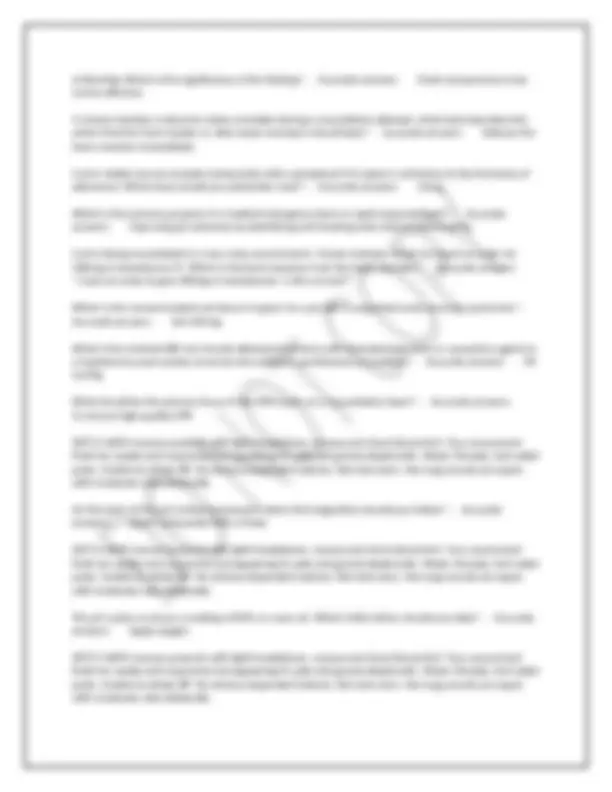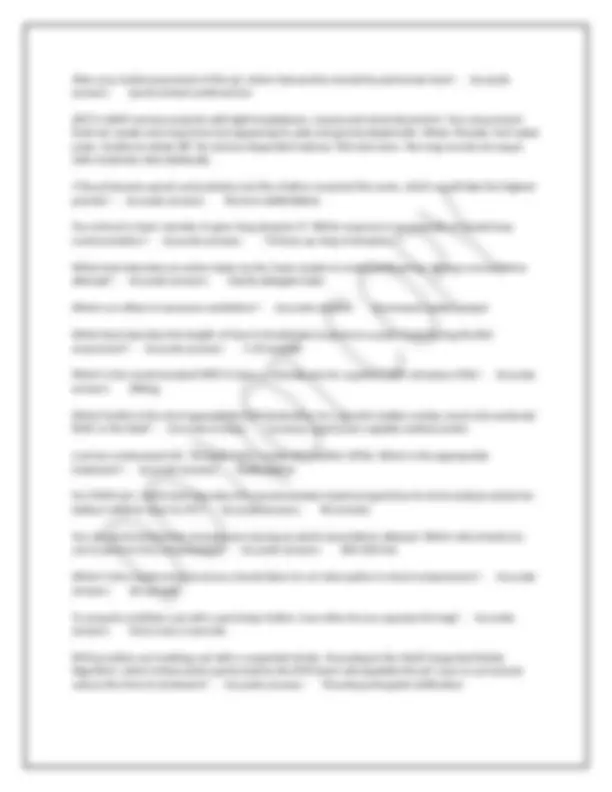





Study with the several resources on Docsity

Earn points by helping other students or get them with a premium plan


Prepare for your exams
Study with the several resources on Docsity

Earn points to download
Earn points by helping other students or get them with a premium plan
Community
Ask the community for help and clear up your study doubts
Discover the best universities in your country according to Docsity users
Free resources
Download our free guides on studying techniques, anxiety management strategies, and thesis advice from Docsity tutors
ACLS EXAM A 2025 QUESTIONS WITH 100% ACCURATE ANSWERS
Typology: Exams
1 / 5

This page cannot be seen from the preview
Don't miss anything!




Which of these tests should be performed for a pt with suspected stroke as early as possible but no more than 20 min after hospital arrival? - Accurate answers Noncontrast CT scan of head Which best describes this rhythm? - Accurate answers Monomorphic Vent Tach Which is an acceptable method of selecting an appropriately sized oropharyngeal airway? - Accurate answers Measure from the corner of the mouth to the angle of mandible You are caring for a pt with a suspected stroke whose symptoms started 2 hours ago. The CT scan was normal, with no signs of hemorrhage. The pt does not have any contraindications to fibrinolytic therapy. Which treatment is best for this pt? - Accurate answers Give fibrinolytic therapy as soon as possible and consider endovascular therapy Which is the recommended next step after a defibrillation attempt? - Accurate answers Resume CPR, starting with chest compressions Which of the following signs is a likely indicator of cardiac arrest in an unresponsive pt? - Accurate answers Agonal gasps You are evaluating a 58YO man with chest discomfort. His BP is 92/50 mmHG, his HR is 92/min, his nonlabored RR is 14/min, and his pulse ox is 97%. Which assessment step is most important now? - Accurate answers Obtaining a 12-lead ECG During post-cardiac arrest care, which is the recommended duration of targeted temperature management after reaching the correct temperature range? - Accurate answers At least 24 hours Your rescue team arrives to find a 59YO man lying on the kitchen floor. You determine that he is unresponsive. What is the next step in your assessment and management of this pt? - Accurate answers Check the pt's breathing and pulse (SET) A 45YO man had coronary stents placed 2 days ago. Today he is in severe distress and is reporting "crushing" chest discomfort. Pale, diaphoretic, cool to touch, weak radial pulse, BP 64/40 mmHg, RR 28/min, 89% RA. VTach changed to VFib. On the basis of this pt's initial presentation, which condition do you suspect led to the cardiac arrest? - Accurate answers Acute Coronary Syndrome (SET) A 45YO man had coronary stents placed 2 days ago. Today he is in severe distress and is reporting "crushing" chest discomfort. Pale, diaphoretic, cool to touch, weak radial pulse, BP 64/40 mmHg, RR 28/min, 89% RA. VTach changed to VFib.
In addition to defibrillation, which intervention should be performed immediately? - Accurate answers Chest compressions (SET) A 45YO man had coronary stents placed 2 days ago. Today he is in severe distress and is reporting "crushing" chest discomfort. Pale, diaphoretic, cool to touch, weak radial pulse, BP 64/40 mmHg, RR 28/min, 89% RA. VTach changed to VFib. Despite 2 defib attempts, the pt remains in VFib. Which drug and dose should you administer FIRST to this pt? - Accurate answers Epi 1mg (SET) A 45YO man had coronary stents placed 2 days ago. Today he is in severe distress and is reporting "crushing" chest discomfort. Pale, diaphoretic, cool to touch, weak radial pulse, BP 64/40 mmHg, RR 28/min, 89% RA. VTach changed to VFib. Despite the drug provided above and continued CPR, the pt remains in VFib. Which other drug should be administered NEXT? - Accurate answers Lido 1 to 1.5mg/kg (SET) A 45YO man had coronary stents placed 2 days ago. Today he is in severe distress and is reporting "crushing" chest discomfort. Pale, diaphoretic, cool to touch, weak radial pulse, BP 64/40 mmHg, RR 28/min, 89% RA. VTach changed to VFib. The pt has ROSC and is not able to follow commands. Which immediate post-cardiac arrest care intervention do you choose for this pt? - Accurate answers Initiate targeted temperature management (SET) A 45YO man had coronary stents placed 2 days ago. Today he is in severe distress and is reporting "crushing" chest discomfort. Pale, diaphoretic, cool to touch, weak radial pulse, BP 64/40 mmHg, RR 28/min, 89% RA. VTach changed to VFib. Which would you have done first if the pt had not gone into VFib? - Accurate answers Performed synchronized cardioversion How can you increase chest compression fraction during a code? - Accurate answers Charge the defib 15s before conducting a rhythm check A team member is unable to perform an assigned task because it is beyond the team member's scope of practice. Which action should the team member take? - Accurate answers Ask for a new task or role In addition to clinical assessment, which is the most reliable method to confirm and monitor correct placement of the ET tube? - Accurate answers Continuous waveform capnography Your pt is in cardiac arrest and has been intubated. To assess CPR quality, which should you do? - Accurate answers Monitor the pt's PETCO Three minutes into a cardiac arrest resuscitation attempt, one member of your team inserts an ET tube while another performs chest compressions. Capnography shows a persistent waveform and a PETCO
After your initial assessment of this pt, which intervention should be performed next? - Accurate answers Synchronized cardioversion (SET) A 68YO woman presents with light-headedness, nausea and chest discomfort. Your assessment finds her awake and responsive but appearing ill, pale and grossly diaphoretic. Weak, thready, fast radial pulse. Unable to obtain BP. No obvious dependent edema, flat neck veins. Her lung sounds are equal, with moderate rales bilaterally. If the pt became apneic and pulseless but the rhythm remained the same, which would take the highest priority? - Accurate answers Perform defibrillation You instruct a team member to give 1mg atropine IV. Which response is an example of closed-loop communication? - Accurate answers "I'll draw up 1mg of atropine." Which best describes an action taken by the Team Leader to avoid inefficiencies during a resuscitation attempt? - Accurate answers Clearly delegate tasks What is an effect of excessive ventilation? - Accurate answers Decreased cardiac output Which best describes the length of time it should take to perform a pulse check during the BLS assessment? - Accurate answers 5-10 seconds Which is the recommended FIRST IV dose of amiodarone for a patient with refractory VFib? - Accurate answers 300mg Which facility is the most appropriate EMS destination for a pt with sudden cardiac arrest who achieved ROSC in the field? - Accurate answers Coronary reperfusion-capable medical center A pt has a witnessed LOC. The lead II ECG reveals this rhythm (VFib). Which is the appropriate treatment? - Accurate answers Defibrillation For STEMI pt's, which best describes the recommended maximum goal time for first medical contact-to- balloon inflation time for PCI? - Accurate answers 90 minutes You are performing chest compressions during an adult resuscitation attempt. Which rate should you use to perform the compressions? - Accurate answers 100-120/min Which is the maximum interval you should allow for an interruption in chest compressions? - Accurate answers 10 seconds To properly ventilate a pt with a perfusing rhythm, how often do you squeeze the bag? - Accurate answers Once every 6 seconds EMS providers are treating a pt with a suspected stroke. According to the Adult Suspected Stroke Algorithm, which critical action performed by the EMS team will expedite this pt's care on arrival and reduce the time to treatment? - Accurate answers Provide prehospital notification
What is the recommended range from which a temperature should be selected and maintained constantly to achieve targeted temperature management after cardiac arrest? - Accurate answers 32C to 36C A responder is caring for a pt with a history of CHF. The pt is experiencing shortness of breath, a BP of 68/50 mmHg, and a HR of 190/min. The pt's lead II ECG is displayed. - Accurate answers Unstable SVT